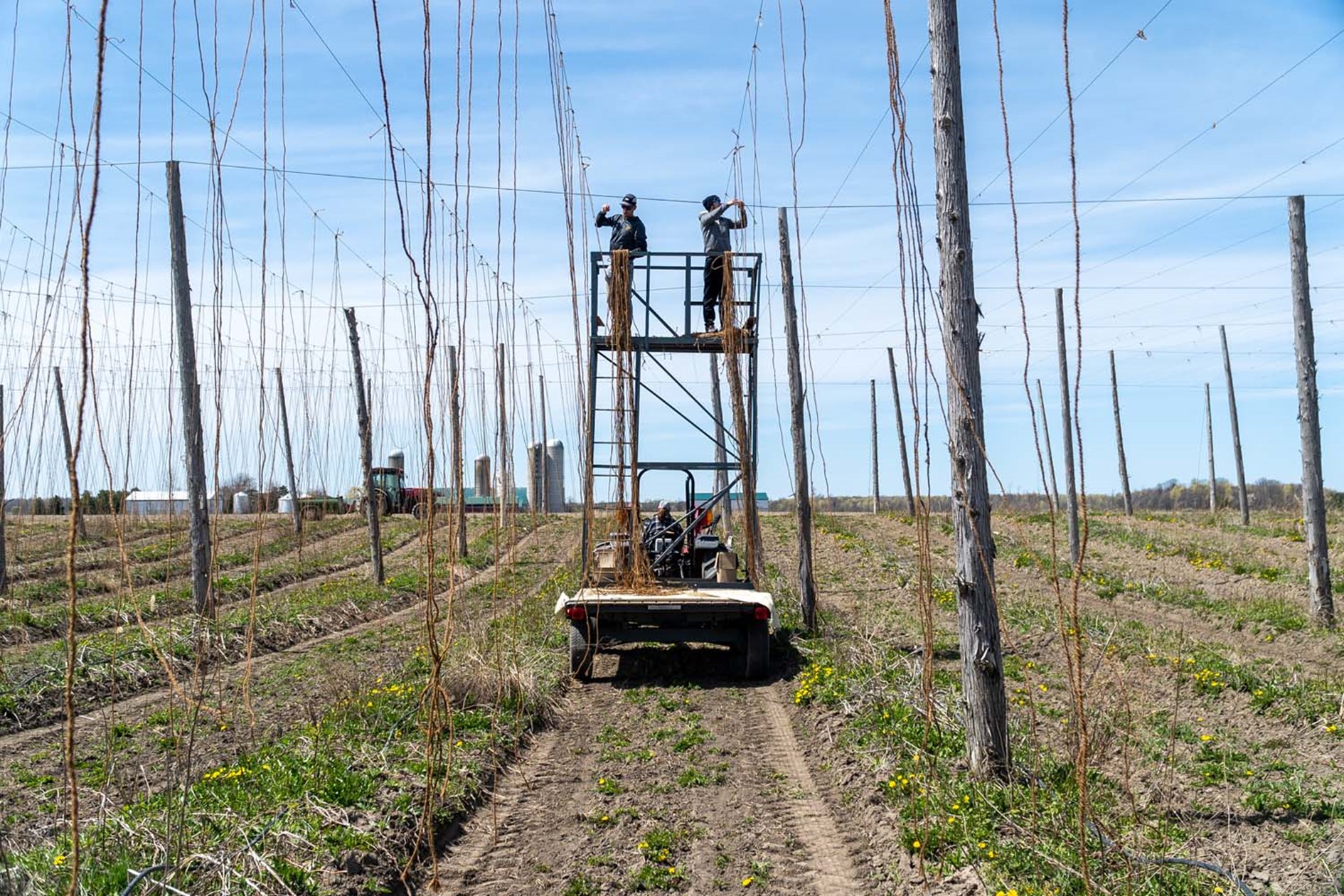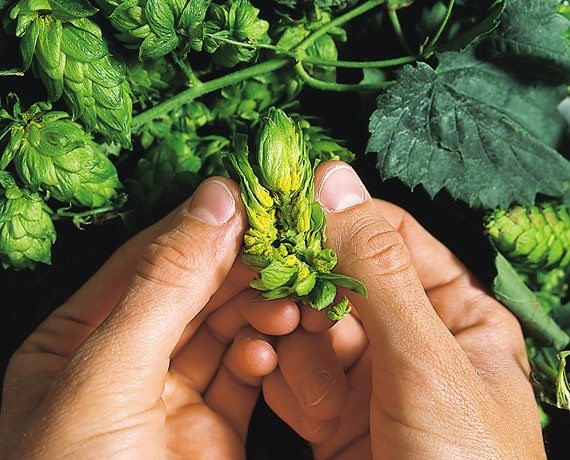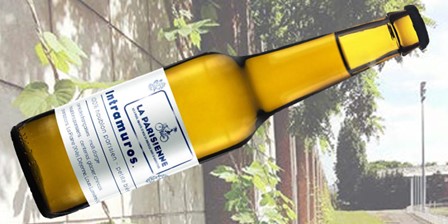Hop harvesting, from the XXth century to nowadays (practices, machines, techniques, ..)
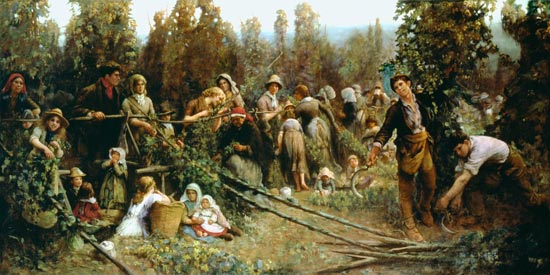
article written in collaboration with Alexandra Berry .
Origins of hop growing
Hops have been cultivated since about 200 A.D. in Babylon and the first written records of hop harvesting date back to 859. Records of hop cultivation are found in 1348 in Žatec (now known for hop cultivation). Saaz).*
*The first written mention of hops as an ingredient in beer appeared in the 12th century, thanks to the research and writings of the abbess Hildegarde Von Bingen. In her natural encyclopedia Physica Sacra, she lists medicinal plants and their virtues, with a particular passion for hops .
Emperor Charles IV (1316-1378), Emperor of the Holy Roman Empire, greatly promoted this culture through a royal decree and a ban on the export of Bohemian varieties, which were already sought after by brewers. In 1538, Prince Christoph von Pappenheim of Eichstatt, a small principality in today's Bavaria, awarded the very first hop seal and certificate to the town of Spalt, south of Nuremberg. Other surrounding principalities, such as Žatec and Plattau, later received the same honor. These seals guarantee that the hops come from the promoted region and become one of the first examples of the hop appellations we know today.
In the 14th century, the regions of Flanders and Bohemia were the main resources of hops for beers produced in Europe.
The English Hop Harvest
These varieties were imported into England as early as the 1400s but were still considered by the local brewers to be illegal additions (the addition of hops to beer was even forbidden in 1471 in Norwchich). They were then imported from France, Holland and Germany. It was not until 1524 that the first hop plants appeared in the south-east of England, more precisely in Kent. With its favourable soil for this plant (rich soils and a lot of irrigation), the region was also prolific in wood and coal, which allowed the installation of many drying kilns for hops*.
*Initially, Flemish Red Bines hops were planted, but they did not adapt to the English climate and soil. So new varieties were created with crossbreeding. Towards the end of the 18th century, the Whitebines were replaced by the Goldings. At the beginning of the XIXth century, these hops were distributed everywhere in England, becoming the standard of the English hops with the Fuggle.
The 19th century was the golden age for the hop industry, with hop gardens spreading across the country to reach 77,000 hectares of cultivation by 1878. The popularization of Pale Ale andIndia Pale Ale did much to encourage this agriculture.
Pasteurization (requiring less hops to preserve the beer), the importation of international varieties and the advent of Lagers will put a stop to this growth. In 1909, there were only 32,000 hectares of hop fields left in the country.
Just 23 years later, there are only 16,500 hectares of production confined to the West Midlands and South Eastern regions of England. These areas became the cradles of the harvest attracting crowds of farmers for a few months each year to help with the harvest.
The United States: the El Dorado of hops
The cultivation of hops spread to America in the 16th century by crossing different known plants and native plants in order to be able to adapt to different soils. Initially imported from England, the Massachusetts Bay Colony ordered seeds and plants in 1629 in order to start a local agriculture. The first commercial transactions of American varieties date from 1648 for a brewery in Massachusetts. This state remained the largest supplier of hops for 150 years. The hop gardens were scattered throughout the surrounding states in New England (Maine, Vermont, New Hampshire, Massachusetts, Connecticut and Rhode Island).
* These hops and the revival of the Craft in the United States will allow the creation of the New England IPA at The Alchemist, the famous Heady Topper. To read more about it, it is by here.
The climate, fertile soil and regular irrigation of the northeastern United States, as well as the region's farming heritage, favored the development and yield of hop farms. Starting in the 1890s, many of these were established in the Yakima Valley region, known for its hot, dry summers and regular, abundant irrigation (thanks to the river of the same name), ideal for growing hops*.
*By the end of the 19th century, about 12,000 farmers and ranchers were required to produce the annual harvest.
Techniques of hop cultivation
How to grow your hops?
The hop plant goes through the same life cycle every year. In March, the hop growers attach the hop vines along metal supports connected by natural coir ropes so that they can grow upwards and proliferate. The space between each support is measured precisely according to the variety
This string crossing follows a regular pattern designed to optimize yield and harvesting depending on the hop variety and can exceed 6 meters in height.
Budding usually starts in early April. At this time, the hops are tied to the ropes, sometimes up to 2 or 3 lianas on the same rope, it is the "setting to the wire". This practice is still done by hand. From spring on, the irrigation or watering of the hop fields starts and is very closely monitored.
By June, the majority of the plants have developed and are attached to their ropes, starting their growth and blooming. By mid-July, the hop plants have reached their maximum height and start to bloom. The first inflorescences and cones develop. During the summer season, the hop grower has to be very careful about possible infections or plagues that could damage the cones and destroy an entire hop field in a few days. Hail storms are also extremely devastating.
Then comes the time to determine when the cones are ready to be harvested! Even though they exude a powerful aroma, it is important to pay attention to the moisture content of the cone to avoid a premature or late harvest. Hop growers keep a close eye on their hops starting in mid-August to avoid missing the optimal window of opportunity.
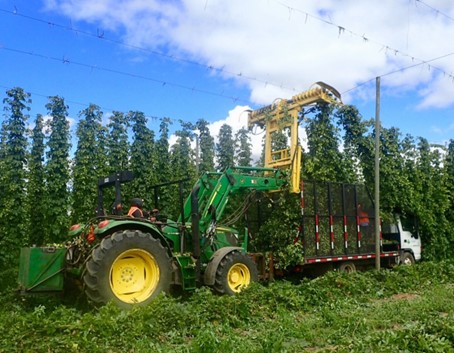
https://www.magneticmag.com/2018/10/celebrating-oregons-annual-hop-harvest-in-portland/
When to harvest your hops?
The hop plant is very resistant to weather and climate and its extracts create a hostile environment for micro-organisms, which protects the flowers from most infections. This also explains the preservative properties of hops in beer. The only bacteria that can survive is yeast, making hops the ideal flavoring agent for brewing.
There will be no precise date recommended to cultivate hops, it will depend on the geographical position of the hop field, its soil, its weather and its cultivar. Generally, the harvest starts around the end of August and can last until October. From this point of view, some varieties are called "early" (Tettnang, Saphir, Styrian Gold...) "medium" (Cascade, Amarillo®, Perle) or "late" (Spalter Select).
The hop growers identify the ideal moment to harvest by relying mainly on the cones. The first approach is empirical and based on the experience and know-how of the hop grower: you have to rub the cone in your hands to analyze the maturity of the leaf and extract the lupulin. The tips of the leaves may be slightly reddish or starting to open, the lupulin is visible in a dark yellow color, the cones are firm, crumpled in the hands and give off a characteristic resinous smell.
The second is based on laboratory analysis to control the moisture content of the cone which must be around 80%. This is done by taking a sample which is then dried. The hop grower can then compare the weight of the dried cone to the fresh cone to determine its moisture content.
A study conducted at Oregon State University in 2011 shows that the essential oil composition of a hop varies depending on its harvest date. The analyses support the idea that the intensity and quality of the aromas increase if a hop is harvested late. Be careful not to wait too long, however, because over-ripening is good for the "plant's reserves" (the reserves the plant will make before winter and for the next season), but not so good for the organoleptic properties of the hops. The right moment of harvesting is also the one that allows the producer an optimal planning - harvesting/drying/baling - of his different varieties. In short, harvesting hops properly is a combination of experience, science and management!
The evolution of the hop harvest
Before the mechanization of the harvest - we will come back to this below - it was done by hand. It was (and still is for some farmers!) exhausting and time-consuming work. The hop vines are cut so that the cones can be detached, one by one.
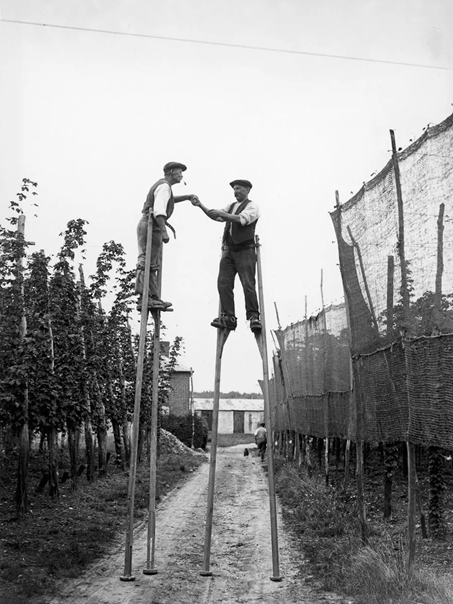
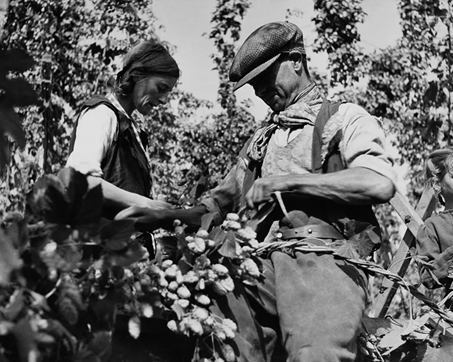
https://rarehistoricalphotos.com/hop-pickers-kent-old-photos/
Historically, farmers recruited en masse for this harvest season, sociological phenomena that have strongly marked the farming life of England for example. Indeed, Kent has been a prolific hop-growing region for several centuries and during the 19th century, it saw large influxes of families from large industrial cities across the country (London, Birmingham mainly) to work during the harvest. These families settled for a period of 3 weeks to 2 months.
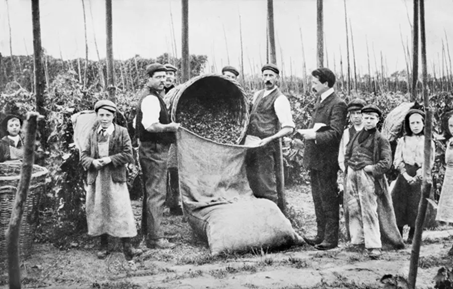
https://rarehistoricalphotos.com/hop-pickers-kent-old-photos/
This agricultural activity grew so much that it even had its own currency to pay the farmers. The coins were stamped with small illustrations of hops and specific to each producer/farm.
In 1922, the first hop harvesting machine was imported from the United States for use by a hop grower in Worcester. Mechanical harvesting became more widely practiced from the 1950s onwards, first becoming more common in the West Midlands. The first English mechanical harvester was built in 1934.
Since the 1950s, mechanical harvesting has intensified, but hop production remains a highly labor-intensive activity. The hop farms, wherever they are in the world, rely on seasonal workers for stringing and harvesting. As some operations cannot be done with machines, hops remain a story of men and women 😉
The "Hopper Huts" that housed the seasonal workers, sometimes in really unsanitary conditions, were destroyed or restored into modern houses or transformed into museums.
The machines in question have arms that "grab" and pull the vines into the system where the cones are detached from their supports, sorting them into one side of the vines and leaves that will then be composted. Able to sort 2 to 3 vines per minute rather than one per hour manually, these machines have revolutionized the harvesting process. These sorters can be mobile to do the sorting in the hop fields. They can also sort hops from foliage.
One machine could replace a hundred farmers and reduce labor time by 90% and production cost by at least 20%.
*The size of farms has increased considerably. In the United States, in the states of Washington and Oregon, some have grown from 400 hectares to an average of 6000 hectares today. U.S. farms are significantly larger than anywhere else in the world.
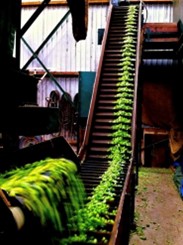
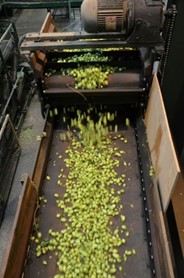
https://stocksfarm.net/the-harvest-workshorse-the-bruff-hop-picker/
The hop harvest is a tradition still celebrated to this day in some places. In England or Germany, some cities transform themselves for harvest with hops hanging everywhere and adorning the windows, marching bands, and the inhabitants gathering to harvest fresh hops together. Some breweries in France now produce their annual Fresh Hop Beer, with hops brewed on the day of their harvest.
The Strisselspalt of Deck & Donohue, La Parisienne and its Intramuros, the Cueillette of the Duchmann brewery
De Ranke Brewery has created its Hop Harvest, a beer brewed with hops grown on the same day, promoted as the "Beaujolais of beer." To be enjoyed worldwide on the third Thursday of November, just like Beaujolais, this celebration honors not only hops, but also the craft, culture and forgotten traditions of the style.
A tradition to be transmitted and celebrated
Historically a celebrated and communal moment, the mechanization of the hop harvest has nevertheless contributed to the forgetfulness of tradition and the ceremonial aspect that accompanied the harvest period. While this has increased yields and reduced production costs, some farmers and brewers are returning to the roots of tradition with hand-harvested hops that are organized on a one-time, festive basis. Harvest Ales are a reminder of the brewers' historical tradition : to be able to brew unique beers with fresh hops.
Just like Beaujolais in November, let's celebrate these annual hop harvests so we can enjoy our favorite beers! Don't hesitate to ask which breweries, farms or hop gardens still organize manual harvests each year.
SOURCES :
Berry, A., (R)Evolution and Craftsmanship in the Service of Beer, (2021) Editions Baudelaire.
https://rarehistoricalphotos.com/hop-pickers-kent-old-photos/
https://americanhopmuseum.org/history
http://www.britishhops.org.uk/
https://backroadshops.com/
https://www.oregonencyclopedia.org/articles/hop_industry/#.Y0-hKXZBy3A


